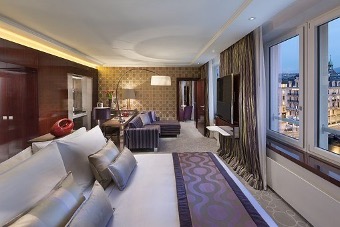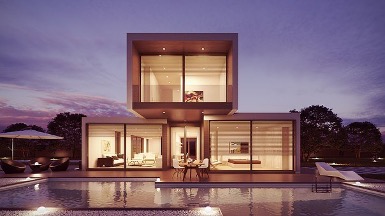
The modular building industry has made several seemingly unrelated splashes in the last decade. Scattered amidst the torrent of information assailing our screens, we have all caught a rumor of a modular hospital built in Wuhan, China in just two weeks. Forbes, CNN, and other major news outlets have reported on the Marriott Hotel chain’s push to build high-rise modular hotels. In 2014, Business Insider reported on the construction of a series of New York modular apartments.
The list goes on.

The news is hardly surprising for many professionals in the modular building industry.
For years they have been touting the benefits of modular construction, highlighting how well these benefits align with some of today’s most pressing needs. For example, as an eco-friendly, less wasteful option, modular construction offers new generations options that fit their values. Furthermore, in 80% of U.S. markets, housing prices are rising faster than wages. Within this scenario, modular may be the long-sought ace in the sleeve for urban development.
From hospitals at full capacity (The Bureau of Labor cites increased demand from caring for the aging baby-boom population, longer life expectancies, and continued growth in the number of patients with chronic conditions), to overwhelmed school systems, to the continuing urbanization of the global population, the types of modern issues addressed by modular construction creates another lengthy list.
When all these data points are compressed into numbers, the picture that emerges is quite clear. According to Allied Market Research, the modular building industry is set to grow at a CAGR of 7.1% between 2019-2026. Yet as the Bureau of Labor Statistics reports, 5 out of 20 of the fastest-growing industries from 2019 to 2029 are in healthcare and social assistance. With these providers turning to modular solutions, it may very well prove that 7.1% CAGR is an understated figure.
Modular Building Industry’s Biggest Hurdles
But that is not the only reason to believe that the prefabricated building industry might very well overperform. The biggest hurdle that modular construction needs to overcome to revolutionize the construction industry is the problem with perception. Firstly, as modular properties are often considered chattel (relocatable buildings), there is a perception that finding competitive mortgages may be a challenge. However, not all modular buildings are chattel, and modular companies are beginning to offer their own financing and leasing packages.
Secondly, there has been a long-standing myth about modular buildings being low quality. This may very well have to do with the association of mobile homes, which are a type of modular building, often also associated with economically depressed areas of the urban landscape.
Yet with modular becoming the spotlight of architecture awards that hail it as “the future of architecture that will take over the world,” and with luxury hotels being built using modular technology, past perceptions of modular building quality are seemingly built on quicksand.

The technological progress accelerates the changing perception of modular buildings.
With tech giants like Facebook and Google, and industry leaders IKEA and Toyota investing in modular building, we can expect many R&D achievements. Future modular buildings will be more affordable, smarter, more aesthetic, and simply more attractive to new generations of home and business owners. Will future modular buildings come pre-set with “Alexa”-style systems that manage dozens of appliances through voice control? With Google and Facebook involved in modular, it is not off the table. As the Covid-19 pandemic proved, the modular building industry is well equipped to modify their buildings with technological turnkey solutions.

Regardless of the vantage point, modular buildings seem poised to continue making splashes into the future. Only the law of the jungle will ultimately decide whether the modular revolution will come to fruition, yet all the right components, from demand, to investment, to current market
share and innovation, seem aligned and pointing in one direction: that modular buildings will take over the world.
Current advantages of modular buildings:
Modular building is green construction. One of the reasons that modular building is the future of building, in addition to being affordable, is because it is good for the environment. Companies everywhere are turning to modular building because:
- Efficiency and quality control
2. Reduction in material waste — Cuts in net waste, incident errors, and accidental damage.
3. Reduction in life cycle energy and carbon — Life cycle structure supports a long-life cycle, energy and carbon cost of construction amortized over a longer period.
4. Reducing energy use for construction — Factories are better able to control energy use and emissions than conventional construction.
5. Transportation reduction related impacts — Cuts greenhouse emissions because there are fewer deliveries and fewer workers commuting.
6. Operational impact (change) reduction — Factory-made homes allow for tighter joints and seams, so portable buildings have more precise air barriers and installation of thermal insulation, the minimization of thermal bridging equals more reliable thermal performance and conservation of energy.
7. Support of adaptation reduce, reuse, recycle
8. Fast construction — Simultaneous site preparation and building construction, while factory conditions allow for fast, high-quality assembly.
For more information contact Aries.
About Aries
Aries produces prefabricated office buildings for a variety of purposes. This includes construction offices, portable school classrooms, mobile hospitals, workforce housing at oil pipeline sites, storage containers, and also disaster recovery relief. But, we are eager to help you find the perfect modular building for your specific needs. Furthermore, we provide complete turnkey solutions, outstanding customer service, and flexible financing options. Our high-quality products, expert design, and cutting-edge technical and financial innovation sets us apart and makes us the go-to choice for customers.
Become a customer today! Visit Aries: www.ariesbuildings.com, or call (U.S.) 1-888-598-6689 You can also contact us via our website, or also request a quote here.

